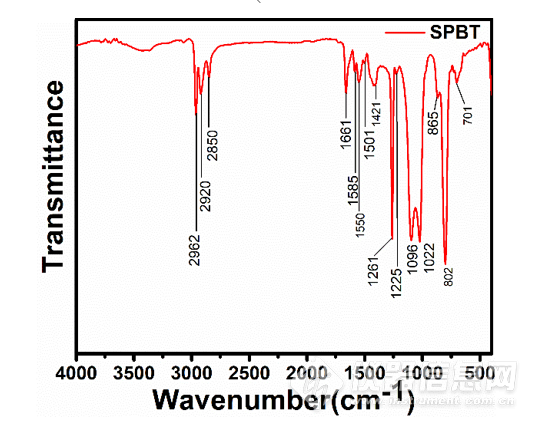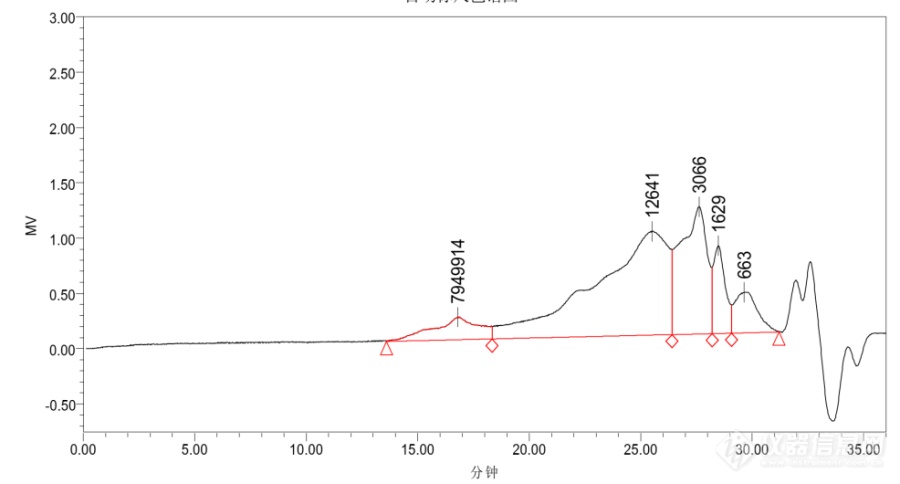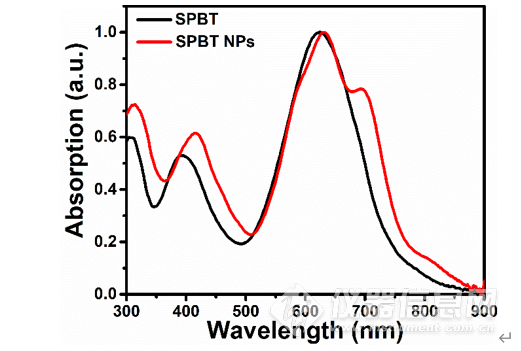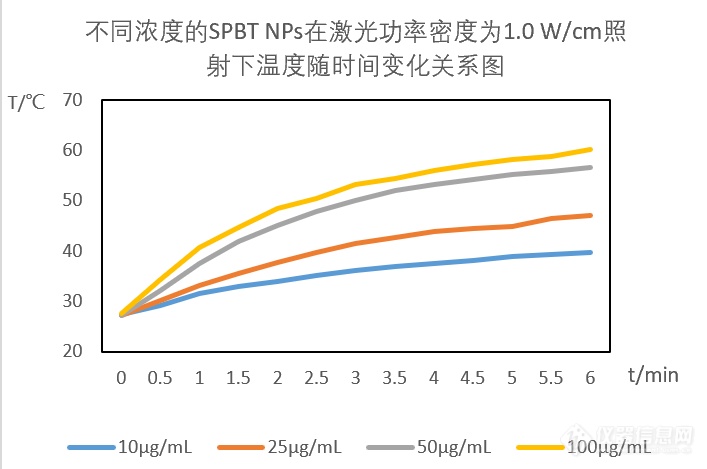

半导体共轭聚合物的表征和抗菌应用
摘要
1.1 实验试剂、材料及仪器
试剂:2,5-bis(6-bromohexyl)-3,6-bis(5-bromothiophen-2-yl)-2,5-dihydropyrrolo[3,4-c]pyrrole-1,4-dione(TDPP)、1,3,5-tris(5-bromopyrimidin-2-yl)benzene(BT)、Pd2(dba)3、P(o-tolyl)3、甲苯、丙酮、正己烷、甲醇、四氢呋喃、氯仿,氘代氯仿、二苯甲酮、去离子水。
1.2聚合物(SPBT)合成与表征
(1)SPBT的合成
(2)SPBT性质表征:
1.通过红外光谱仪SPBT进行分子结构的表征。取少量干燥过的SPBT于研钵中,并加入适量光谱级KBr,研磨均匀后用压片机压成透明片,插入红外光谱仪中进行测试。
2.通过凝胶渗透色谱仪对SPBT进行分子量的表征。称取6mg SPBT于2mL离心管中,加入1mL四氢呋喃溶液溶解过夜,然后送样测试。
1.3聚合物纳米颗粒(SPBT NPs)的制备与表征
(1)SPBT NPs的制备
(2)SPBT NPs的表征
1.4 SPBT NPs的光热性能测试
将200 μL不同浓度(0、10、25、50、100 μg/mL)的SPBT NPs 的水悬浮液注入2 mL 小离心管中,并用1.0 W/cm2, 660 nm激光器照射6min。用红外热成像仪记录温度的变化。
移取200 μL, 50 μg/mL的SPBT NPs于2 mL小离心管中,并用660 nm激光器(1.0 W/cm2)照射溶液6 min,停止照射并自然冷却6min。以此为一个循环,连续反复进行3个循环以测试纳米颗粒的光热稳定性。
移取200 μL, 50 μg/mL的SPBT NPs于2 mL小离心管中,并用660 nm激光器(1.0 W/cm2)照射溶液6 min,然后关闭激光,在室温下自然冷却。
2.1 SPBT和SPBTNPs的合成与表征

Figure 2.1 Synthesis route of SPBT
图2.1 SPBT的合成路线图

Figure 2.2 1H NMR of SPBT
图2.2 SPBT的1H NMR

Figure 2.3 Infrared spectrum of SPBT
图2.3 SPBT的红外光谱图

Figure 2.4 GPC of SPBT
图2.4 SPBT的GPC图

Figure 2.5 The DLS image of SPBT NPs. The inset image is TEM of SPBT NPs. Scale bar: 50 nm
图2.5 SPBT NPs的动态光谱图。插图是SPBT NPs的TEM。标尺:50 nm

Figure 2.6 UV absorption spectra of SPBT and SPBT nanoparticles
图2.6 SPBT和SPBTNPs的的紫外吸收光谱图
 2.2 SPBT NPs的光热性能测试
2.2 SPBT NPs的光热性能测试
图2.6 不同浓度SPBTNPs在激光功率密度为1.0W/cm照射下温度随时间变化关系图
通过still偶联反应,成功地合成了半导体共轭聚合物(SPBT),并通过纳米共沉淀法成功制备了半导体共轭聚合物纳米颗粒溶液(SPBT NPs)。在660 nm激光照射下,SPBT NPs可以有效地将光能转化为热能,并在几分钟内使纳米颗粒溶液产生良好的局部升温表现。这种基于光热响应的半导体聚合物易于制备且具有有效的光热抗菌潜力,可进一步对抗耐药性细菌感染。
[1]WOLFE N D, DUNAVAN C P, DIAMOND J. Origins of major human infectious diseases[J]. Nature, 2007, 447(7142):279-283.
[2] Lu, T K, Collins J J. Engineered Bacteriophage Targeting Gene Networks as Adjuvants for Antibiotic Therapy. Proc. Natl. Acad. Sci. U.S. A. 2009, 106, 4629-4634.
[3] Tew, G N, Scott, R. W, Klein, M. L, et al. De Novo Design of Antimicrobial Polymers, Foldamers, and Small Molecules: From Discovery to Practical Applications. Acc. Chem. Res. 2010, 43, 30-39.
[4] Li P, Poon Y F, Li W F, et al. A Polycationic Antimicrobial and Biocompatible Hydrogel with Microbe Membrane Suctioning Ability. Nat. Mater. 2011, 10, 149-15.
[5] Chen Z, Yuan H X, Liang H Y, et al. Synthesis of Multifunctional Cationic Poly(p-phenylenevinylene) for Selectively Killing Bacteria and Lysosome-Specific Imaging. ACS Appl. Mater. Interfaces 2017, 9, 9260-9264.
[6] Zhang J, Feng Y H, Mi J L, et al. Photothermal Lysis of Pathogenic Bacteria by Platinum Nanodots Decorated Gold Nanorods under Near Infrared Irradiation. J. Hazard. Mater. 2018, 342, 121-130.
[7] Fang W J, Zhang H Y, Wang X, et al. Facile Synthesis of Tunable Plasmonic Silver Core/Magnetic Fe3O4 Shell Nanoparticles for Rapid Capture and Effective Photothermal Ablation of Bacterial Pathogens. New J. Chem. 2017, 41, 10155-10164.
[8] Huang J L, Zhou J F, Zhuang J Y, et al. Strong Near-Infrared Absorbing and Biocompatible CuS Nanoparticles for Rapid and Efficient Photothermal Ablation of Gram-Positive and-Negative Bacteria. ACS Appl. Mater. Interfaces 2017, 9, 36606-36614
[9] Jia X H, Ahmad I, Yang R, et al. Versatile Graphene Based Photothermal Nanocomposites for Effectively Capturing and Killing Bacteria, and for Destroying Bacterial Biofilms. J. Mater. Chem. B. 2017, 5, 2459-2467.
[10] Mocan L, Ilie I, Tabaran F A, et al. Selective Laser Ablation of Methicillin-Resistant Staphylococcus Aureus with IgG Functionalized Multi-Walled Carbon Nanotubes. J. Biomed. Nanotechnol. 2016, 12, 781-788.
[11] PU K, MEI J, JOKERST J V, et al. Diketopyrrolopyrrole-Based Semiconducting Polymer Nanoparticles for In Vivo Photoacoustic Imaging[J]. Adv Mater, 2015, 27(35):5184-90.
[12] LI Y, LIU Z, MA Y, et al. Semiconducting Nanocomposite with AIEgen-Triggered Enhanced Photoluminescence and Photodegradation for Dual-Modality Tumor Imaging and Therapy[J]. Advanced Functional Materials, 2019, 29(38).
[13] WANG Y, LI S, LIU L, et al. Photothermal-Responsive Conjugated Polymer Nanoparticles for the Rapid and Effective Killing of Bacteria[J]. ACS Applied Bio Materials, 2018, 1(1):27-32.
[14] LYU Y, ZENG J, JIANG Y, et al. Enhancing Both Biodegradability and Efficacy of Semiconducting Polymer Nanoparticles for Photoacoustic Imaging and Photothermal Therapy[J]. ACS Nano, 2018, 12(2):1801-1810.